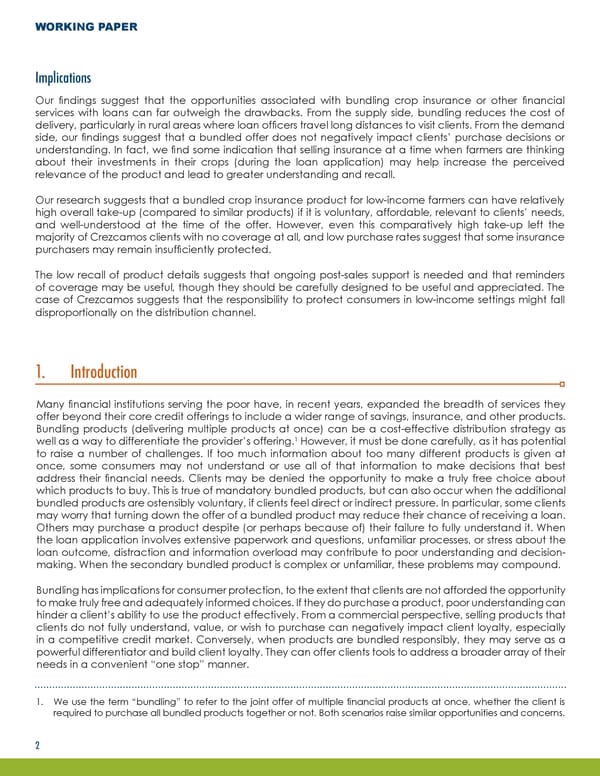WORKING PAPER Implications Our findings suggest that the opportunities associated with bundling crop insurance or other financial services with loans can far outweigh the drawbacks. From the supply side, bundling reduces the cost of delivery, particularly in rural areas where loan officers travel long distances to visit clients. From the demand side, our findings suggest that a bundled offer does not negatively impact clients’ purchase decisions or understanding. In fact, we find some indication that selling insurance at a time when farmers are thinking about their investments in their crops (during the loan application) may help increase the perceived relevance of the product and lead to greater understanding and recall. Our research suggests that a bundled crop insurance product for low-income farmers can have relatively high overall take-up (compared to similar products) if it is voluntary, affordable, relevant to clients’ needs, and well-understood at the time of the offer. However, even this comparatively high take-up left the purchase rates suggest that some insurance majority of Crezcamos clients with no coverage at all, and low purchasers may remain insufficiently protected. The low recall of product details suggests that ongoing post-sales support is needed and that reminders of coverage may be useful, though they should be carefully designed to be useful and appreciated. The case of Crezcamos suggests that the responsibility to protect consumers in low-income settings might fall disproportionally on the distribution channel. 1. Introduction Many financial institutions serving the poor have, in recent years, expanded the breadth of services they offer beyond their core credit offerings to include a wider range of savings, insurance, and other products. Bundling products (delivering multiple products at once) can be a cost-effective distribution strategy as 1 well as a way to differentiate the provider’s offering. However, it must be done carefully, as it has potential to raise a number of challenges. If too much information about too many different products is given at once, some consumers may not understand or use all of that information to make decisions that best address their financial needs. Clients may be denied the opportunity to make a truly free choice about which products to buy. This is true of mandatory bundled products, but can also occur when the additional bundled products are ostensibly voluntary, if clients feel direct or indirect pressure. In particular, some clients may worry that turning down the offer of a bundled product may reduce their chance of receiving a loan. Others may purchase a product despite (or perhaps because of) their failure to fully understand it. When the loan application involves extensive paperwork and questions, unfamiliar processes, or stress about the loan outcome, distraction and information overload may contribute to poor understanding and decision- making. When the secondary bundled product is complex or unfamiliar, these problems may compound. Bundling has implications for consumer protection, to the extent that clients are not afforded the opportunity to make truly free and adequately informed choices. If they do purchase a product, poor understanding can hinder a client’s ability to use the product effectively. From a commercial perspective, selling products that clients do not fully understand, value, or wish to purchase can negatively impact client loyalty, especially in a competitive credit market. Conversely, when products are bundled responsibly, they may serve as a powerful differentiator and build client loyalty. They can offer clients tools to address a broader array of their needs in a convenient “one stop” manner. 1. We use the term “bundling” to refer to the joint offer of multiple financial products at once, whether the client is required to purchase all bundled products together or not. Both scenarios raise similar opportunities and concerns. 2
 Responsible Bundling of Microfinance Services Page 4 Page 6
Responsible Bundling of Microfinance Services Page 4 Page 6